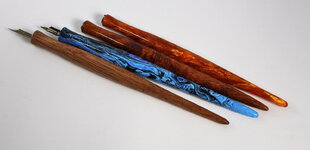npenn
Member
I'm sorry if this has been posted before.
I'm looking at beginning to make my own pens. I love fountain pens and I'm looking for a hobby. Pen turning will hopefully grab and keep my attention.
A lot of the pen kits and things I see aren't geared towards fountain pens, they are more towards regular roller balls. I will attempt those too but mainly wanting to focus on fountain calligraphy pens. Any information would be greatly accepted on how to make and where to find what I need for the process.
I'm looking at beginning to make my own pens. I love fountain pens and I'm looking for a hobby. Pen turning will hopefully grab and keep my attention.
A lot of the pen kits and things I see aren't geared towards fountain pens, they are more towards regular roller balls. I will attempt those too but mainly wanting to focus on fountain calligraphy pens. Any information would be greatly accepted on how to make and where to find what I need for the process.

